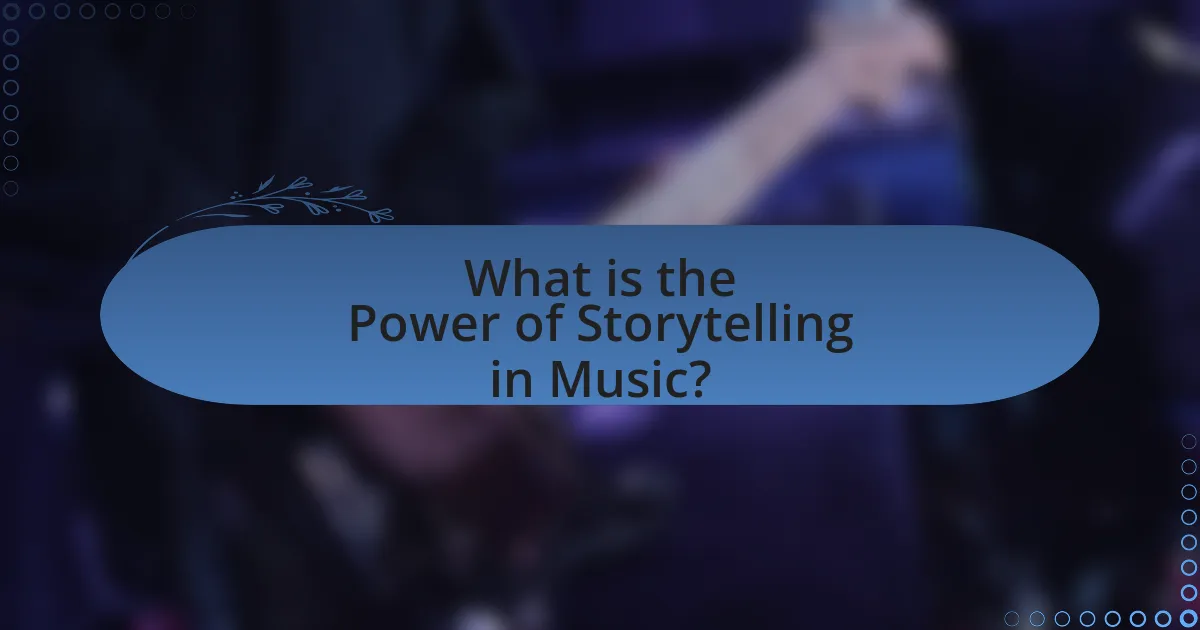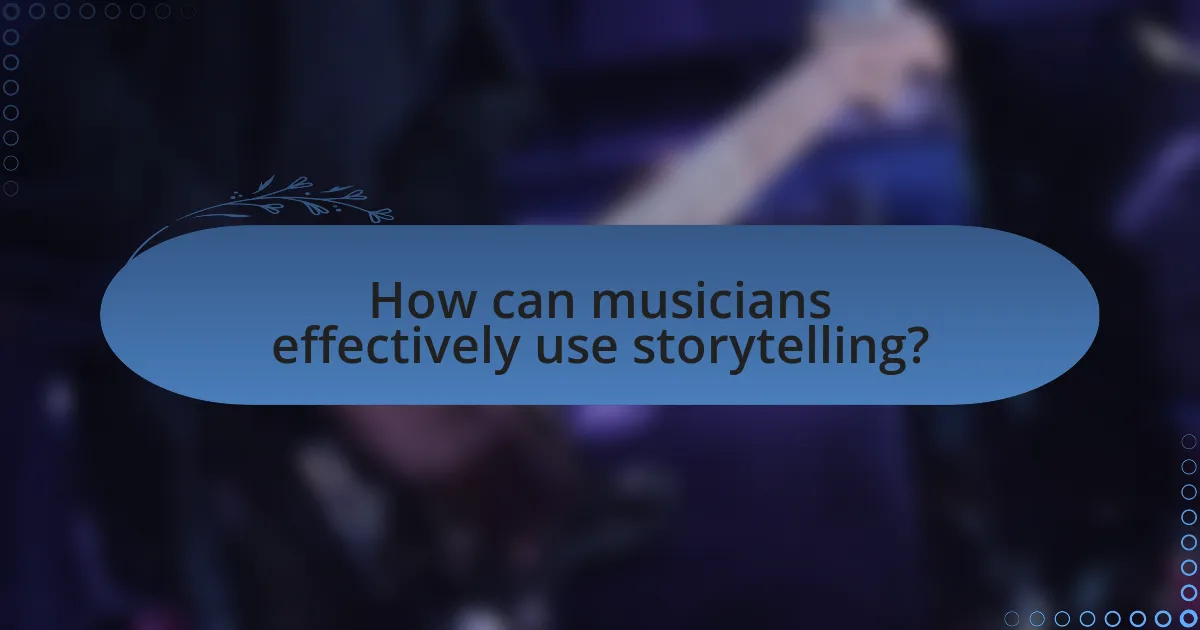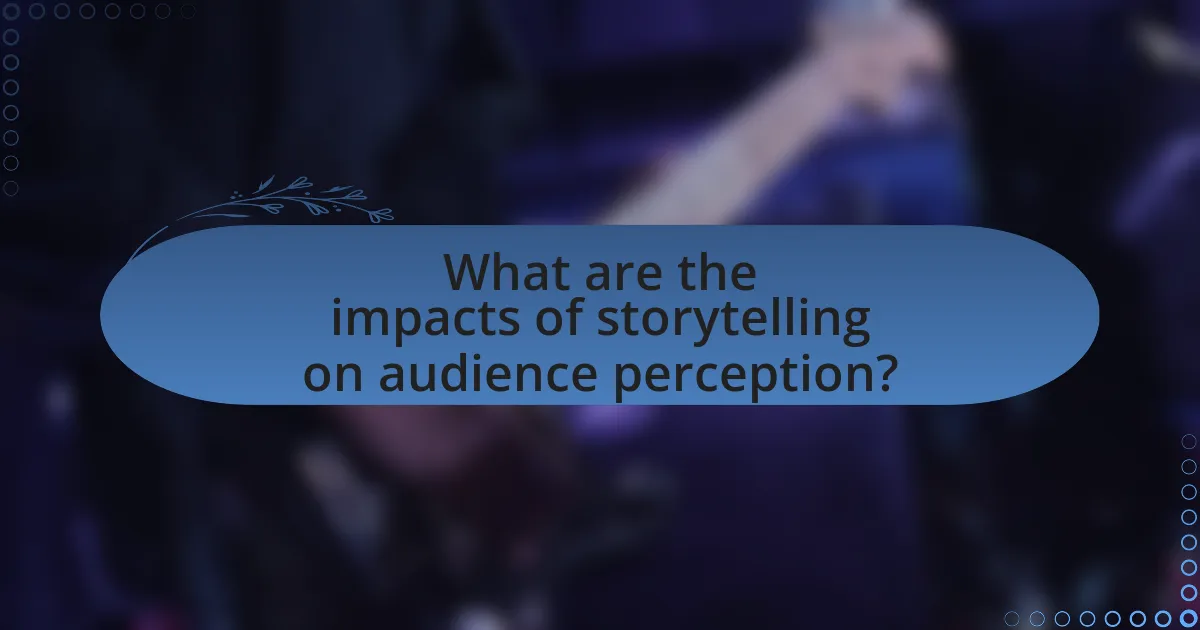The article explores the power of storytelling in music and its significant role in enhancing audience engagement. It highlights how narrative elements evoke emotions, create connections, and improve listener retention, with examples from various genres such as country, hip-hop, and rock. Key components of effective musical storytelling include character development, plot structure, and thematic depth, which collectively foster a deeper emotional investment from the audience. Additionally, the article discusses techniques for musicians to incorporate storytelling into their work, the psychological effects of narratives on listeners, and notable artists and songs that exemplify successful storytelling in music.

What is the Power of Storytelling in Music?
The power of storytelling in music lies in its ability to evoke emotions, create connections, and enhance audience engagement. Music that incorporates narrative elements allows listeners to relate personally to the themes and experiences presented, fostering a deeper emotional response. For instance, songs like “The River” by Bruce Springsteen narrate personal and societal struggles, resonating with listeners through shared experiences. Research indicates that storytelling in music can increase listener retention and emotional impact, as narratives provide context that enriches the auditory experience. This connection is supported by studies showing that songs with clear narratives often achieve higher popularity and listener engagement metrics.
How does storytelling influence audience engagement in music?
Storytelling significantly enhances audience engagement in music by creating emotional connections and fostering relatability. When musicians incorporate narratives into their songs, listeners are more likely to resonate with the themes and experiences presented, leading to a deeper emotional investment. Research indicates that songs with clear storytelling elements can evoke stronger emotional responses, as evidenced by a study published in the Journal of Music Therapy, which found that narrative-driven music increased listener engagement and emotional expression. This connection not only captivates the audience but also encourages them to share their own stories, further amplifying their engagement with the music and the artist.
What are the key elements of storytelling in musical narratives?
The key elements of storytelling in musical narratives include character development, plot structure, emotional arc, and thematic depth. Character development allows listeners to connect with the protagonists or narrators, while plot structure provides a framework for the unfolding of events, often following a traditional arc of exposition, rising action, climax, and resolution. The emotional arc engages the audience by evoking feelings that resonate with their own experiences, and thematic depth offers insights or messages that enhance the overall meaning of the narrative. These elements work together to create a compelling musical experience that captivates and retains audience engagement.
How do different genres utilize storytelling techniques?
Different genres utilize storytelling techniques by employing distinct narrative structures, character development, and thematic elements that resonate with their audiences. For instance, country music often tells personal stories of love, loss, and hardship, using relatable lyrics and straightforward melodies to evoke emotional responses. In contrast, hip-hop frequently incorporates social commentary and personal experiences, utilizing rhythm and rhyme to enhance the storytelling aspect, as seen in tracks like “Fight the Power” by Public Enemy, which addresses systemic racism. Rock music may use metaphor and allegory, as demonstrated in songs like “Bohemian Rhapsody” by Queen, which presents a complex narrative through varied musical styles. Each genre adapts storytelling techniques to fit its cultural context and audience expectations, thereby enhancing engagement and emotional connection.
Why is narrative important for musicians and composers?
Narrative is important for musicians and composers because it enhances emotional connection and engagement with the audience. By weaving stories into their music, artists can evoke specific feelings and create memorable experiences that resonate with listeners. Research indicates that music paired with a narrative can increase emotional responses, as demonstrated in studies where participants reported stronger feelings when listening to music that told a story compared to abstract compositions. This connection not only captivates the audience but also fosters a deeper understanding of the themes and messages conveyed through the music.
How can narrative enhance emotional connection with listeners?
Narrative enhances emotional connection with listeners by creating relatable experiences that evoke empathy and understanding. When a story is told, it allows listeners to immerse themselves in the characters’ emotions and situations, fostering a sense of shared experience. Research indicates that narratives activate brain regions associated with emotional processing, such as the amygdala, which suggests that storytelling can significantly influence emotional responses. For instance, a study published in the journal “Cognitive Science” by Paul Zak found that stories can increase oxytocin levels, a hormone linked to bonding and empathy, thereby deepening the emotional connection between the storyteller and the audience.
What role does narrative play in the creative process of music-making?
Narrative plays a crucial role in the creative process of music-making by providing a framework for emotional expression and thematic development. Musicians often use narrative to convey stories, experiences, or emotions, which enhances the listener’s connection to the music. For instance, songs like “The River” by Bruce Springsteen illustrate personal struggles and triumphs, allowing audiences to relate to the narrative and feel a deeper emotional resonance. Research indicates that narratives in music can significantly increase listener engagement, as they create a shared experience that fosters empathy and understanding. This connection is supported by studies showing that music with a strong narrative structure is more likely to be remembered and appreciated by audiences.

How can musicians effectively use storytelling?
Musicians can effectively use storytelling by weaving narratives into their lyrics and performances to create emotional connections with their audience. This approach allows musicians to convey personal experiences, cultural tales, or universal themes, making their music more relatable and impactful. For instance, Bruce Springsteen’s storytelling in songs like “The River” captures the struggles of working-class life, resonating deeply with listeners and enhancing their engagement. Research indicates that storytelling in music can increase listener retention and emotional response, as narratives evoke empathy and foster a sense of shared experience.
What techniques can be employed to weave narratives into music?
Techniques to weave narratives into music include lyrical storytelling, thematic development, and the use of musical motifs. Lyrical storytelling involves crafting lyrics that convey a clear story arc, often with characters, conflict, and resolution, as seen in songs like “The River” by Bruce Springsteen. Thematic development allows composers to explore a central idea or emotion throughout a piece, creating a cohesive narrative experience, exemplified in Gustav Mahler’s symphonies. Additionally, musical motifs can represent specific characters or themes, enhancing the narrative by providing auditory cues, similar to how John Williams uses motifs in film scores. These techniques effectively engage audiences by creating relatable and immersive experiences.
How can lyrics contribute to storytelling in songs?
Lyrics contribute to storytelling in songs by providing a narrative framework that conveys emotions, characters, and events. Through carefully chosen words and phrases, lyrics can evoke imagery and create a vivid scene, allowing listeners to connect with the story on a personal level. For example, Bob Dylan’s “Tangled Up in Blue” uses detailed storytelling techniques to unfold a complex narrative involving multiple perspectives and timelines, illustrating how lyrics can enhance the depth of a song’s message. This narrative quality in lyrics not only engages the audience but also fosters a deeper emotional response, making the song memorable and impactful.
What are the benefits of using visual storytelling in music videos?
Visual storytelling in music videos enhances audience engagement by creating a deeper emotional connection to the music. This technique allows artists to convey complex narratives that resonate with viewers, making the experience more memorable. Research indicates that narratives can increase viewer retention and emotional response; for instance, a study published in the Journal of Consumer Research found that stories can improve recall by up to 22 times compared to non-narrative content. Additionally, visual storytelling can help to establish a unique brand identity for the artist, differentiating them in a crowded market. By integrating compelling visuals with music, artists can evoke specific emotions and themes, ultimately leading to a more impactful and immersive experience for the audience.
How can live performances enhance storytelling in music?
Live performances enhance storytelling in music by creating an immersive experience that engages the audience emotionally and physically. The dynamic interaction between the performer and the audience allows for real-time feedback, which can amplify the emotional weight of the narrative being conveyed. For instance, studies show that live music can evoke stronger emotional responses compared to recorded music, as the presence of a performer adds a layer of authenticity and connection. Additionally, visual elements such as stage design, lighting, and choreography can complement the musical narrative, making the story more vivid and memorable. This multi-sensory engagement fosters a deeper understanding and appreciation of the story being told through the music.
What elements of stage presence contribute to narrative delivery?
Elements of stage presence that contribute to narrative delivery include body language, vocal modulation, eye contact, and audience engagement. Body language conveys emotions and intentions, enhancing the storytelling aspect by visually representing the narrative. Vocal modulation, such as changes in pitch and tone, adds depth and emphasis to key moments, making the story more compelling. Eye contact establishes a connection with the audience, fostering engagement and making the narrative feel more personal. Lastly, audience engagement techniques, such as call-and-response or interactive elements, invite participation, further immersing the audience in the narrative experience. These elements collectively enhance the effectiveness of storytelling in music performances.
How can audience interaction amplify the storytelling experience?
Audience interaction amplifies the storytelling experience by creating a dynamic relationship between the storyteller and the audience, fostering emotional engagement and participation. When audiences actively engage, such as through call-and-response techniques or interactive elements, they become co-creators of the narrative, which enhances their emotional investment. Research indicates that interactive storytelling can increase retention and empathy; for instance, a study published in the Journal of Media Psychology found that participants who engaged with interactive narratives reported higher levels of emotional connection and memory recall compared to passive viewers. This evidence supports the idea that audience interaction not only enriches the storytelling experience but also deepens the overall impact of the narrative.

What are the impacts of storytelling on audience perception?
Storytelling significantly impacts audience perception by enhancing emotional connection and engagement. When narratives are woven into music, they create a relatable context that allows listeners to connect personally with the content. Research indicates that stories activate the brain’s mirror neurons, which facilitate empathy and understanding, making the audience more receptive to the message being conveyed. For instance, a study published in the journal “Psychological Science” by Paul Zak found that narratives can increase oxytocin levels, a hormone associated with bonding and trust, thereby influencing how audiences perceive and respond to the music. This emotional resonance leads to a deeper appreciation and retention of the musical experience.
How does narrative shape listener interpretation of music?
Narrative shapes listener interpretation of music by providing context and emotional depth that influences how the music is perceived. When a song is accompanied by a story, listeners often engage more deeply, as narratives can evoke specific emotions and memories, guiding their understanding of the music’s themes. Research indicates that narratives can enhance memory retention and emotional responses; for instance, a study published in the journal “Psychology of Music” by Bruner (1990) highlights that storytelling can significantly affect how individuals process and remember musical experiences. This connection between narrative and music interpretation underscores the importance of storytelling in enhancing audience engagement.
What psychological effects does storytelling have on audiences?
Storytelling significantly impacts audiences by evoking emotions, enhancing empathy, and improving memory retention. Research indicates that narratives activate brain regions associated with emotional processing, leading to stronger emotional responses compared to non-narrative information. For instance, a study by Paul Zak found that stories can increase oxytocin levels, fostering feelings of connection and empathy among listeners. Additionally, storytelling aids in memory retention; studies show that people are 22 times more likely to remember information when it is presented in a narrative format. This psychological engagement through storytelling not only captivates audiences but also facilitates deeper understanding and connection to the content presented.
How can storytelling influence audience loyalty and engagement?
Storytelling significantly influences audience loyalty and engagement by creating emotional connections and fostering a sense of belonging. When narratives resonate with audiences, they evoke emotions that enhance their attachment to the content, leading to increased loyalty. Research indicates that stories activate the brain’s emotional centers, making the audience more likely to remember and relate to the message. For example, a study published in the journal “Psychological Science” found that narratives can increase information retention by up to 65%, demonstrating how effective storytelling can enhance engagement and loyalty among listeners.
What are some examples of successful storytelling in music?
Successful storytelling in music can be exemplified by songs like “The River” by Bruce Springsteen, which narrates the struggles of working-class life and lost dreams, and “Fast Car” by Tracy Chapman, which tells a poignant story of escape and longing for a better life. These songs effectively engage listeners by weaving relatable narratives that evoke strong emotions. Additionally, “The Night the Lights Went Out in Georgia” by Vicki Lawrence presents a dramatic tale of betrayal and injustice, showcasing how storytelling can create vivid imagery and emotional resonance. Each of these examples demonstrates how narrative elements in music can enhance audience engagement and create lasting connections.
Which artists are known for their narrative-driven music?
Artists known for their narrative-driven music include Bob Dylan, Taylor Swift, and Bruce Springsteen. Bob Dylan’s songwriting often tells intricate stories, as seen in songs like “Tangled Up in Blue,” which features a complex narrative structure. Taylor Swift is recognized for her storytelling ability, particularly in albums like “Folklore” and “Evermore,” where she crafts detailed character-driven narratives. Bruce Springsteen’s work, especially in “Born to Run,” encapsulates vivid storytelling that reflects the American experience. These artists effectively engage audiences through their compelling narratives, making their music resonate on a deeper emotional level.
What are notable albums or songs that exemplify storytelling?
Notable albums that exemplify storytelling include “The Wall” by Pink Floyd, which narrates the life of a troubled rock star, and “American Pie” by Don McLean, which recounts the changes in American society through the lens of music history. Additionally, “The Miseducation of Lauryn Hill” features personal narratives about love and identity, while “Good Kid, M.A.A.D City” by Kendrick Lamar tells a vivid story of growing up in Compton. Each of these works uses lyrical narratives to engage listeners, illustrating the power of storytelling in music.
What best practices can musicians adopt for effective storytelling?
Musicians can adopt several best practices for effective storytelling, including creating relatable characters, using vivid imagery, and structuring their narratives with a clear beginning, middle, and end. By developing characters that resonate with listeners, musicians can foster emotional connections, as seen in the storytelling techniques of artists like Taylor Swift, who often draws from personal experiences. Utilizing vivid imagery in lyrics enhances the listener’s ability to visualize the story, making it more engaging; for example, Bruce Springsteen’s “Thunder Road” paints a detailed picture of hope and escape. Additionally, a well-structured narrative helps maintain listener interest and provides a satisfying resolution, as demonstrated in concept albums like Pink Floyd’s “The Wall,” which tells a cohesive story throughout its tracks. These practices not only enhance the storytelling aspect of music but also significantly increase audience engagement.